According to statistics, this disease develops more often in women than in men. These veins appear in the legs and become more common with age.
Further in the article important facts about varicose veins are noted, the corresponding photos are given for a better understanding of what they look like, what they are and how to treat them.
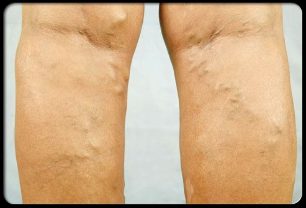
What are varicose veins?
Varicose veins are abnormally dilated veins that usually develop in the legs. Usually blue, purple or leather.Looks like dilated, twisted and swollen blood vessels that can protrude above the surface of the skin.
What are spider veins?
Spider veins (also called telangiectasias or spider veins, vessels) are a collection of tiny blood vessels that grow near the surface of the skin.They are often red, blue or purple and look like tissue. The most common spider veins are found on the face and legs.
What causes varicose veins?
Varicose veins are caused by structural abnormalities in the blood vessels.Veins carry blood from various parts of the body back to the heart. They have a series of one-way valves to prevent blood flow.
For a variety of reasons, these valves can be damaged, causing blood to flow back into the veins. Further stagnation of blood increases the pressure inside the vein and weakens the wall of blood vessels.
Then, due to the stagnation of the blood and the expansion of the affected blood vessels, arachnids and varicose veins develop.
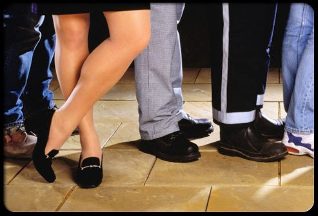
The reasons for the development?
There are many different risk factors that increase a person's chances of developing varicose veins.
These include:
- old age,
- prolonged posture or sitting,
- obesity,
- pregnancy,
- hormone therapy,
- taking birth control pills,
- injuries,
- previous surgical vein,
- history of venous thrombosis,
- family history.
Symptoms of varicose veins
Varicose veins often do not show any symptoms or signs other than their undesirable aesthetic appearance. However, some people may experience some of the symptoms of varicose veins.Symptoms may include:
- swelling,
- pulse sensation
- pain in pain,
- burning sensation,
- itching,
- seriousness,
- tingling or leg cramps.
These symptoms often get worse after prolonged sitting or standing. Individuals may also develop brown skin and eventually food ulcers.
Complications of varicose veins
If varicose veins are not treated, this can lead to the following:
- Trophic skin ulcers develop. These open sores usually appear on the lower leg. They can sometimes lead to the development of a soft tissue infection.
- Blood clots appear inside the veins (superficial thrombophlebitis).
- Possible bleeding from veins.
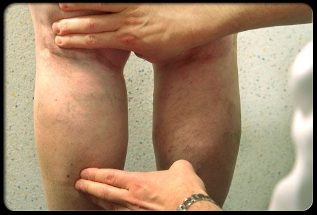
Diagnostics of the vascular network and varicose veins of the legs
To diagnose the presence of varicose veins in the legs, you can carefully examine the affected area, which is usually the feet.
The examination consists of visual examination and palpation of the problem area. Particular attention is paid to areas of redness, swelling, discoloration of the skin and food ulcers.
Home treatment
There are several methods you can apply at home to alleviate some of your symptoms if they occur. These conservative methods can also help prevent complications.
Compression socks
Compression stockings are a simple home remedy for foot symptoms.
They improve blood circulation by increasing the pressure on the legs. These socks are available in different types and compression strengths. Your doctor can recommend a suitable pair for you. It is usually sold in pharmacies.

Lifestyle change
A regular exercise and weight loss program can help relieve the symptoms of arachnids and varicose veins.
Affected people should avoid standing or sitting for long periods of time and raising their legs while sitting or sleeping to improve circulation and reduce swelling in the legs.Sclerotherapy
Sometimes conservative treatment of varicose veins at home may not give the desired results. In these cases, more specialized medical procedures can be performed, depending on the location and size of the abnormal veins.
These medical procedures are often performed for cosmetic purposes.
Sclerotherapy is a common technique that can be performed by a doctor. It is very effective in eliminating most spider veins and some varicose veins.
During this procedure, which does not require anesthesia, the doctor injects a liquid solution directly into the affected vein, causing it to stick together and eventually disappear. Multiple sessions may be needed to achieve optimal results. Possible side effects include bruising, swelling, bleeding, infection and discoloration of the skin.
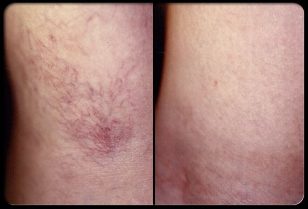
Sclerotherapy: before and after
Sclerotherapy treatments may require multiple sessions and treatment time may vary from person to person.
Generally, spider veins begin to disappear within 3-6 weeks after treatment, and varicose veins may take several months to heal.
Laser treatment of varicose veins
Laser treatment is another alternative medical procedure that can also be performed by a doctor. It is sometimes used in addition to sclerotherapy to maximize results. This technique is most effective for spider veins and small varicose veins.
For patients who are afraid of needles, laser treatment provides an alternative treatment option, although a doctor can advise you on which treatment is best for your particular case.
Laser treatment uses a focused beam of light to heat the affected blood vessel, which eventually disappears.
Possible side effects include slight redness or swelling around the treatment area, discoloration of the skin, blisters and rare scars.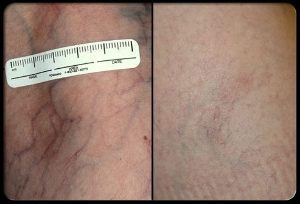
Laser treatment is a newly developed treatment for varicose veins, in which the affected area is treated with light pulses of different limits.
Laser treatment: before and after the procedure
As with sclerotherapy, many laser sessions are often required to achieve optimal results. Improvement can take several weeks to several months after treatment.
Surgical vein
Surgery is a treatment option for more severe cases of varicose veins. Your doctor will discuss with you the various possible surgeries to help you decide which varicose vein treatment is best for you. One of the surgical methods is to bandage the veins and remove them through small incisions in the skin.
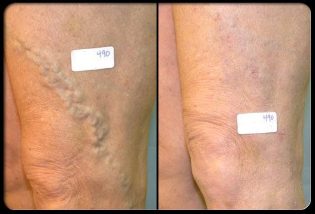
Surgical vein: before and after treatment
Degeneration and removal of veins often successfully relieves the symptoms and cosmetic problems of varicose veins. This operation is performed under local, spine or general anesthesia in a hospital.
Complete recovery from this surgery usually takes about 2-4 weeks. Possible complications may include infection, bleeding, scarring, nerve damage, deep vein thrombosis, and adverse reactions to anesthesia.
Intravenous laser treatment
Intravenous laser treatment is a minimally invasive surgery that involves laser radiation through a thin tube inserted into the affected vein, causing tightening.Intravenous laser treatment has an initial success rate of 98%. This procedure is performed in outpatients under local anesthesia or light sedation.
Patients report less pain and faster recovery with intravenous laser treatment compared to ligation and removal of veins with surgery.
Remove radio frequencies
Intravenous radiofrequency ablation is a minimally invasive procedure similar to intravenous laser treatment.
Instead of using laser light, a catheter inserted into a vein uses radiofrequency energy, which heats and shrinks the affected vessel. As with intravenous laser treatment, patients report less pain and faster recovery compared to ligation and vein removal with surgery.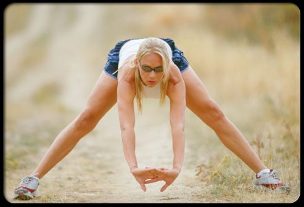
Prevention of varicose veins
Although varicose veins are not always preventative, there are several methods you can follow to reduce your chances of developing them.Prevention tips include:
- Regular exercise?
- Maintain a healthy weight.
- Avoid prolonged sitting or standing posture.
- Avoid pinching your feet while sitting.
- Raise your legs higher when you rest.
- Do not wear clothes that compress your body around your waist, groin and legs.
Dear friends. This article is not a medical advice and should not be used as a substitute for medical advice.




































